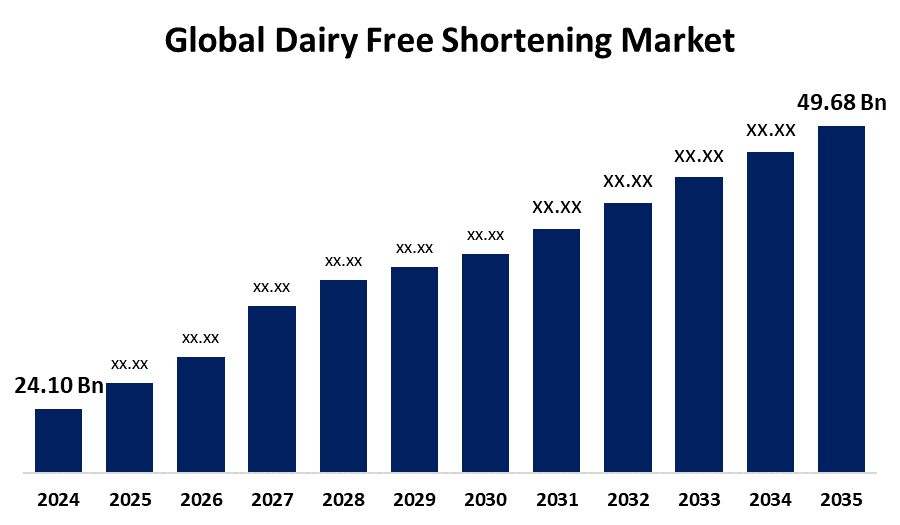Global Dairy Free Shortening Market Size, Share, and COVID-19 Impact Analysis, By Product Type (Beverages, Milk, Dairy-free Kefir, and Bakery Products), By Application (Household and Commercial), and By Region (North America, Europe, Asia-Pacific, Latin America, Middle East, and Africa), Analysis and Forecast 2025 - 2035.
Industry: Food & BeveragesGlobal Dairy Free Shortening Market Insights Forecasts to 2035
- The Global Dairy Free Shortening Market Size Was Estimated at USD 24.10 Billion in 2024
- The Market Size is Expected to Grow at a CAGR of around 6.80% from 2025 to 2035
- The Worldwide Dairy Free Shortening Market Size is Expected to Reach USD 49.68 Billion by 2035
- Asia Pacific is expected to Grow the fastest during the forecast period.

Get more details on this report -
The Global Dairy Free Shortening Market Size was worth around USD 24.10 Billion in 2024 and is predicted to Grow to around USD 49.68 Billion by 2035 with a compound annual growth rate (CAGR) of 6.80% from 2025 to 2035. The rising health awareness, lactose intolerance, and plant-based diet trends drive strong demand for dairy-free shortenings. Their stability, allergen-free nature, and growing availability position them as key ingredients in the evolving sustainable and ethical food market.
Market Overview
The dairy-free shortening market is a kind of shortening that is free of dairy products and derivatives. Shortening is a solid fat used in baking and cooking to provide flaky textures and softness. In contrast to traditional shortening, which occasionally contains whey or milk fats, dairy-free shortening is manufactured from plant-based oils or fats like palm, soybean, or coconut oil, making it appropriate for those who are vegan, lactose intolerant, or allergic to dairy.
The rising consumer demand for ethical, health-conscious, and ecological food options, the market for dairy-free shortening is expand quickly. In addition to meeting dietary needs, plant-based shortenings derived from oils like coconut and palm support environmental sustainability. The increasing demand for premium, dairy-free substitutes is satisfied by their adaptable use in baked goods, snacks, and confections. Market growth is also fueled by health advantages, such as reduced cholesterol, and is suitable for vegan and lactose-intolerant consumers. Better shelf stability also makes them more desirable to producers. In general, the move to plant-based and allergy-friendly food products is making dairy-free shortening a crucial component.
Report Coverage
This research report categorizes the dairy free shortening market based on various segments and regions, forecasts revenue growth, and analyzes trends in each submarket. The report analyses the key growth drivers, opportunities, and challenges influencing the dairy free shortening market. Recent market developments and competitive strategies such as expansion, type launch, development, partnership, merger, and acquisition have been included to draw the competitive landscape in the market. The report strategically identifies and profiles the key market players and analyses their core competencies in each sub-segment of the dairy free shortening market.
Global Dairy Free Shortening Market Report Coverage
| Report Coverage | Details |
|---|---|
| Base Year: | 2024 |
| Market Size in 2024: | USD 24.10 Billion |
| Forecast Period: | 2025-2035 |
| Forecast Period CAGR 2025-2035 : | 6.80% |
| 2035 Value Projection: | USD 49.68 Billion |
| Historical Data for: | 2020-2023 |
| No. of Pages: | 240 |
| Tables, Charts & Figures: | 110 |
| Segments covered: | By Product Type, By Application and By Region |
| Companies covered:: | Nutiva Inc., Groupe Danone, Bunge Limited, Cargill, Incorporated, AarhusKarlshamn AB (AAK), Archer Daniels Midland Company, Manildra Group, AAK AB, Mewah Group, Wilmar International Limited, NMGK Group, IOI Group, Fuji Oil Holdings Inc., IFFCO Group, Sime Darby Plantation Berhad, and Others |
| Pitfalls & Challenges: | COVID-19 Impact, Challenges, Future, Growth, & Analysis |
Get more details on this report -
Driving Factors
The growing awareness of health issues, lactose intolerance, and the global trend toward plant-based and vegan diets is driving the market for dairy free shortening. Customers favor plant-based fats that provide a cholesterol-free substitute as they become more conscious of the negative effects of cholesterol on heart health. There is a high demand for allergen-free products due to the rising incidence of lactose intolerance and dairy allergies. Dairy-free shortenings are valued by food makers due to their stability and extended shelf life, which complements clean label and transparency trends. Increasing availability via the internet and retail channels aids in the expansion of the industry. All of these elements work together to make dairy-free shortening an essential component of the changing food market, which is centered on sustainability, ethics, and health.
Restraining Factors
The market growth is hindered by the consumer perceptions of poorer taste and texture, despite its great development potential. Stability of supply and affordability may also be impacted by price fluctuations in plant-based raw materials. These elements might impede widespread adoption. Resolving these issues is essential to maintaining market growth.
Market Segmentation
The dairy free shortening market share is classified into product type and application.
- The bakery products segment held the largest share in 2024 and is anticipated to grow at a significant CAGR during the forecast period.
Based on the product type, the dairy free shortening market is classified into beverages, milk, dairy-free kefir, and bakery products. Among these, the bakery products segment held the largest share in 2024 and is anticipated to grow at a significant CAGR during the forecast period. The segmental growth can be attributed to their crucial function in improving shelf life, moisture content, and texture. Manufacturers are adopting these plant-based substitutes in response to the growing demand for vegan and allergy-friendly baked goods. The expansion of plant-based, healthier bread goods is aided by this trend. The market for dairy-free shortening is still primarily driven by bakery goods when compared to other categories.
- The household segment accounted for the largest share in 2024 and is estimated to grow at a remarkable CAGR during the forecast period.
Based on the application, the dairy free shortening market is categorized into household and commercial. Among these, the household segment accounted for the largest share in 2024 and is estimated to grow at a remarkable CAGR during the forecast period. The segmental growth can be attributed to the more people are switching to plant-based diets and looking for dairy-free baking and cooking options, the household market is expanding. Due to their convenience and adaptability, dairy-free shortenings are widely used in contemporary kitchens.
Regional Segment Analysis of the Dairy Free Shortening Market
- North America (U.S., Canada, Mexico)
- Europe (Germany, France, U.K., Italy, Spain, Rest of Europe)
- Asia-Pacific (China, Japan, India, Rest of APAC)
- South America (Brazil and the Rest of South America)
- The Middle East and Africa (UAE, South Africa, Rest of MEA)
North America is anticipated to hold the largest share of the dairy free shortening market over the predicted timeframe.

Get more details on this report -
North America is anticipated to hold the largest share of the dairy free shortening market over the predicted timeframe. The regional growth can be attributed to the widespread lactose intolerance and a significant movement in consumer preferences toward plant-based meals. Growing health consciousness and consumer demand for vegan and allergy-free products are driving the U.S. market. Regional growth is also aided by Canada's thriving food processing industry and health-conscious consumers. When taken as a whole, these elements reinforce North America's market dominance.
Asia Pacific is expected to grow at a rapid CAGR in the dairy free shortening market during the forecast period. The region's growth is being driven by the growing urbanization, growing vegan and lactose-intolerant populations, and growing health consciousness. The demand for plant-based and dairy-free goods is also rising as a result of increasing disposable incomes and the adoption of Western eating habits. Market expansion in this region is further accelerated by developing food processing industries and growing retail channels in nations like China, India, and Japan.
Competitive Analysis:
The report offers the appropriate analysis of the key organizations/companies involved within the dairy free shortening market, along with a comparative evaluation primarily based on their type of offering, business overviews, geographic presence, enterprise strategies, segment market share, and SWOT analysis. The report also provides an elaborative analysis focusing on the current news and developments of the companies, which includes type development, innovations, joint ventures, partnerships, mergers & acquisitions, strategic alliances, and others. This allows for the evaluation of the overall competition within the market.
List of Key Companies
- Nutiva Inc.
- Groupe Danone
- Bunge Limited
- Cargill, Incorporated
- AarhusKarlshamn AB (AAK)
- Archer Daniels Midland Company
- Manildra Group
- AAK AB
- Mewah Group
- Wilmar International Limited
- NMGK Group
- IOI Group
- Fuji Oil Holdings Inc.
- IFFCO Group
- Sime Darby Plantation Berhad
- Others
Key Target Audience
- Market Players
- Investors
- End-users
- Government Authorities
- Consulting And Research Firm
- Venture capitalists
- Value-Added Resellers (VARs)
Key Recent Development
- In June 2022, Danone is introducing the Dairy and Plants Blend, the first baby formula that combines important dairy components with 60% plant-based protein derived primarily from high-quality, non-GMO soybeans. Designed for vegetarian and flexitarian parents, it promotes healthy baby growth while supporting plant-based eating habits.
Market Segment
This study forecasts revenue at global, regional, and country levels from 2020 to 2035. Spherical Insights has segmented the dairy free shortening market based on the below-mentioned segments:
Global Dairy Free Shortening Market, By Product Type
- Beverages
- Milk
- Dairy-free Kefir
- Bakery Products
Global Dairy Free Shortening Market, By Application
- Household
- Commercial
Global Dairy Free Shortening Market, By Regional Analysis
- North America
- US
- Canada
- Mexico
- Europe
- Germany
- UK
- France
- Italy
- Spain
- Russia
- Rest of Europe
- Asia Pacific
- China
- Japan
- India
- South Korea
- Australia
- Rest of Asia Pacific
- South America
- Brazil
- Argentina
- Rest of South America
- Middle East & Africa
- UAE
- Saudi Arabia
- Qatar
- South Africa
- Rest of the Middle East & Africa
Need help to buy this report?